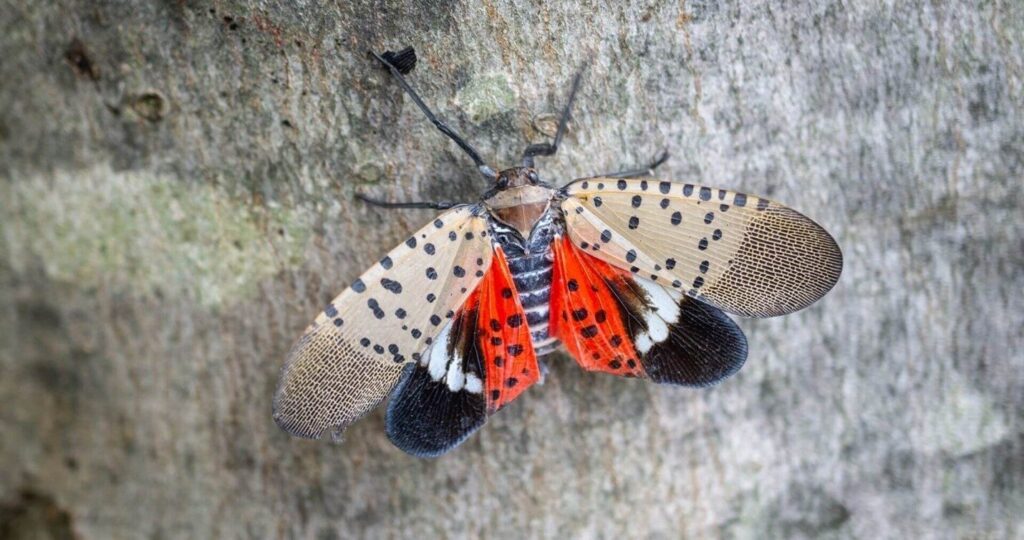An invasive organism is one that is introduced to a non-native habitat and causes ecological harm. This definition is still contentious among naturalists, horticulturalists, arborists, and all green industry professionals. Here are some high-risk potential invasive pests to watch out for in Illinois in 2024.
Asian Longhorned Beetle (ALB)

Asian longhorned beetle (ALB) is a potentially devastating invasive insect that had previously been spotted in Illinois back in 1998 and subsequently considered eradicated from the state in 2008. However, ALB is still present in other US states and may return to Illinois, which is why scouting and monitoring is so vital.
ALB is a hardwood borer and feeds on the vascular tissues of trees during the larval stage of their development. They can feed on Maple, Buckeye, Birch, Elm, Ash, Sycamore, Katsura, and other trees. Maples are a preferred host, making this pest particularly dangerous for areas where Maple makes up a large portion of the canopy. ALB is native to Asia and is a large beetle when mature, as long as 1 ¼” in length with long antennae over 2 times their body length. Because they are so large and heavy, ALB is not an adept long-distance flyer. They are jet black with white spots and their antenna are distinctly white and black banded.
In their native region of the world, ALB has numerous natural predators and parasites that help keep their population under control. In the US, these natural predators aren’t around to keep the population in check. They can be very difficult to control, and no known insecticidal treatments exist. Management includes removing infested trees and scouting vigilantly for new populations.
Spongy Moth (formerly Gypsy Moth)

The spongy moth is an invasive defoliator pest originally introduced in 1869. Populations have fluctuated since its introduction. Management programs have helped limit the spread and distribution throughout the state and country.
The damage from spongy moths occurs during their caterpillar stage where the insect will defoliate large areas of tree canopy. Smaller populations may not be as harmful to a healthy plant, but large populations may defoliate large sections of forests at a time. Their preferred feeding host is unfortunately our very important and beloved Oak trees. Defoliation damage isn’t typically fatal to a tree but can be detrimental to plant health.
Caterpillars are distinctly marked with 5 pairs of blue bumps and 6 pairs of red bumps. Nobody is sure why the spongy moth caterpillars chose police light colors as markings, but we suspect it may be to arrest the attention of potential predators.
After feeding, the caterpillars enter a pupal stage and emerge as adults in July. The male adults will fly to mate, but the females are completely flightless. Wrapping tree trunks with a sticky double-sided tape can be a relatively effective control for spongy moths, as they need to climb a tree to lay their egg mass after mating. They can, however, lay their egg mass on all sorts of objects from tree limbs to car tires or shipping containers. This is why inspection is so crucial for objects leaving quarantine zones.
Spotted Lanternfly (SLF)

The spotted lanternfly is a very recent invasive insect officially spotted in Illinois for the first time in September of 2023. SLF is a sucking insect similar to aphids, but they produce very large amounts of honeydew compared to these smaller pests. Their honeydew production can attract other pests such as wasps, and the sticky substance itself is a nuisance in public spaces. When populations are large enough, feeding by SLF can also be detrimental to plant health though not known to be fatal. Their preferred hosts include the invasive tree of heaven, various types of maples, and a list of other potential but less preferred feeding hosts.
SLF overwinter as egg masses that hatch out in late spring to early summer. The newly emerged nymphs will feed on a host tree for several weeks before maturing into an adult around July. The adults will mate and lay eggs into September, creating egg masses that will overwinter and continue the lifecycle next spring.
Although SLF are not a prolific flier, they may lay egg masses on vehicles similar to spongy moths and hitch a ride, so to speak. It is important to inspect vehicles during late summer when making long trips to be certain you have no stowaway SLF on board!
Management includes mechanical removal and destruction of egg masses, and removal of preferred host plants such as tree of heaven. Report any suspected sightings. Insecticidal treatments are available and effective, but can only be applied by licensed pesticide handlers.
Battling Invaders
If you think you may have sighted any of these pests, contact the Illinois Cooperative Agricultural Pest Survey Program at [email protected] with details about the location, date of sighting, and photographs, along with your name and contact information.
Keep your eyes peeled this summer for these invasive insect pests, and help keep Illinois free from more damaging tree insects.
